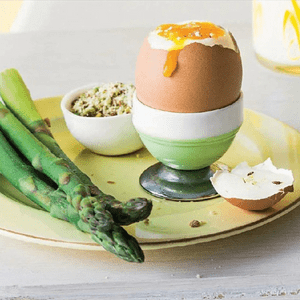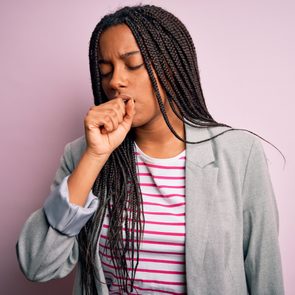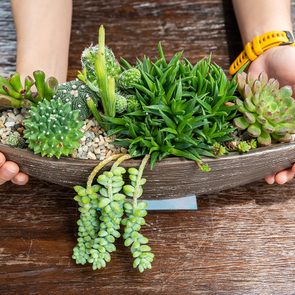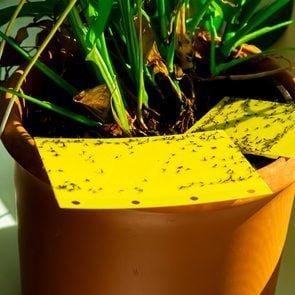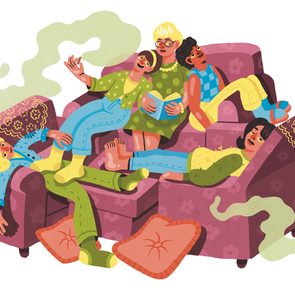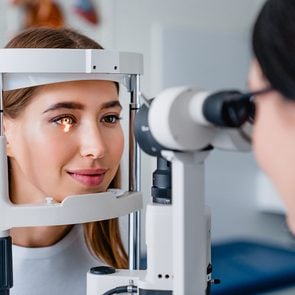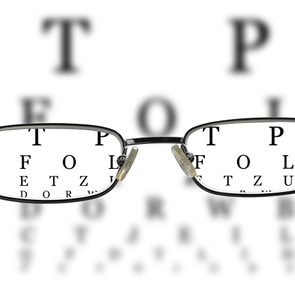Newsflash: It’s mayonnaise!
Grossed out? Don’t be. At its most basic level, this common condiment is made up of vinegar, eggs, and oil (plus a small amount of an emulsifier such as mustard). There’s nothing scary about these ingredients, right? You’ll find them individually or together as mayo, in many baked goods. But we bet you didn’t know that you can use mayo as a secret ingredient in soft, super fluffy pancakes, too.
Why mayo is a magical ingredient
When it comes to baking science, vinegar is actually the most important part of mayonnaise. An acid, vinegar reacts with baking soda to kick off the production of carbon dioxide, which gives the batter a lift as it bakes. The acidity also causes the flour’s proteins to gently unravel, producing a tender cake that is fluffy and moist.
Eggs are bakery workhorses. When separated and whipped, egg whites are able to trap air, which helps many recipes rise and makes way for sweet treats like meringues. For their part, egg yolks provide a source of fat to help keep cakes tender. In mayonnaise, eggs provide the aforementioned fat; they can also act as a binder in pancake and cake recipes.
Most pancake recipes use oil, which has 20 per cent more fat than butter (and you don’t have to soften or cream it first). Scientifically, this matters because when more fat is involved, less gluten is formed. Gluten is a protein that provides structure, so while it’s necessary to some degree, too much can dry out baked goods and make them dense. The lipids in the oil coat the flour and render it unable to absorb moisture, effectively preventing the over-formation of gluten. (Here are the cooking mistakes that are ruining your food.)
How to get super fluffy pancakes using mayonnaise
To get that extra lift, stir a few tablespoons of mayonnaise into your pancake batter along with the egg and the oil. If you’re worried about tasting the mayonnaise in the finished pancake, fret not—unless you’re using an unusually strong-tasting brand, the only evidence of its use will be a supremely fluffy flapjack.
And if you want to take it a step further, savvy cooks in Japan have discovered that mayonnaise plus a splash of carbonated water can produce a super tall pancake that soaks up maple syrup like a sponge… a win-win!
Next, find out the secret ingredient for extra-fluffy scrambled eggs.
If divorce drove me from New Zealand to the United Kingdom in 1996, it was marriage that drew me five years later to Jasper, Alberta. And once more I had to embrace a new way of living. It was just as well that I had a powerful incentive, as the extreme cold for which Canada was known terrified me.
But I discovered that Canadians had found the antidote to cold temperatures in their centrally heated and exceptionally well-insulated houses. I was astonished to be warmer in my Jasper home during the depths of winter than I’d been in temperate New Zealand in an uninsulated house.
Blissfully warm indoors, I turned my attention to withstanding the cold outdoors. Down feathers proved supremely effective, and once I adjusted to my new silhouette, not dissimilar to that of a Sumo wrestler, I relaxed in the cocooning coziness of my down jacket. With the addition of a toque, sky gloves and Sorels, I was ready for winter.
Or so I thought. Correct attire kept me warm, but it couldn’t help me balance on icy sidewalks. I had to relearn how to walk, exchanging my long strides for the indignity of a penguin’s waddle. One winter’s afternoon, I arrived at an icy intersection just as a car pulled up. I waved the driver on, as I would be slow to cross, but with typical Canadian courtesy, he insisted I go ahead. Oh, the humiliation of hobbling across the ice-rutted road with him watching every one of my painstaking steps!
Fear of slipping and injuring myself threatened to turn me into a recluse until my husband Phil bought me a pair of cleats for my boots. They gave me the freedom to walk safely downtown, but had one major drawback: they were difficult to put on and take off. The task was manageable at home, where I could rest my feet on a backdoor step, but this option wasn’t available while shopping. I was guilt-ridden at the damage the cleats might cause to the floor and so I skulked around, treading lightly to lessen the cleats’ telltale “clack, clack clack.” I suppose I could have sat on my bottom like a toddler to ease the cleats on and off, but that never appealed to me.
With my warmth and safety secured, all that remained was to deal with my negative attitude towards the cold. Greetings of, “Isn’t it a beautiful day?” when the temperature was well below zero initially baffled me if not irritated me. But when I experienced how wind chill made my cheeks ache and extreme cold made icicles of my nasal hairs and turned my earrings into instruments of torture, I too came to realize that any sunny winter’s day without wind and severe cold was, indeed, a beautiful day. (Don’t miss this gorgeous gallery of Canadian winter photography.)
Another discovery awaited me. I had always loved watching snow fall; it was mesmerizing and I never tired of it. Even at night, I would gaze at the snowflakes illuminated in the streetlight, eddying down as gently and softly as feathers, muffling all sound.
A greater delight was to walk in the snow with it falling around me. Wonderfully dry, it didn’t melt and saturate my clothing, but rather adorned it with tiny white diamonds so fragile they could be scattered by a single breath. Filigree-like flakes alighting on my face produced childlike wonder, as did opening my mouth and catching snowflakes on my tongue.
It was at such moments I realized a change was taking place—just as Phil had captured my heart, so too had Canada.
Next, find out what another recent immigrant wishes he’d known before moving to Canada.
Caffeine is the world’s most popular drug, regularly consumed by hundreds of millions of adults each day in coffee, tea, soft drinks and energy drinks. Most of us need it to get the day started. Without it we feel foggy and sluggish; too much, and we may turn jittery and get nauseous. But nailing the just-right amount makes us pleasantly alert and productive, even slightly euphoric. We’re all addicted, but is that such a bad thing?
For most of us, it’s not. Caffeine is a central nervous system stimulant that relieves fatigue and improves mood, concentration and focus. For some sporty types, it can boost endurance. Health organizations worldwide suggest that most people can safely consume up to 400 milligrams of it a day—roughly the amount in 33 ounces of brewed coffee or 68 ounces of black tea.
Consuming 600 mg or more a day is when things can, quite literally, get shaky: at that volume, some people experience tremors, increased blood pressure, an upset stomach, headaches, dizziness, heart palpitations and insomnia. Then again, some people don’t. Response to caffeine varies from person to person and is likely determined by two main genetic factors: how quickly your liver can metabolize caffeine and whether your central nervous system is more sensitive to stimulatory effects.
While daily consumption of caffeine doesn’t usually disrupt the heart’s rhythm enough to create dangerous irregular patterns, high doses can temporarily raise your heart rate and blood pressure—a danger for people with heart disease. In rare cases, excess caffeine intake has caused seizures and even death, though mostly among people consuming energy drinks.
Some research suggests that caffeine may protect against dementia, including Alzheimer’s disease. One observational study in The Journals of Gerontology: Series A found that women aged 65 and older who consumed an average of 261 mg of caffeine (two to three cups of coffee) a day for 10 years reported fewer dementia symptoms than women who had consumed an average of 64 mg daily. This effect isn’t yet fully understood, and it’s not known whether it’s the caffeine—or other substances in coffee, such as antioxidants—that is the cause. (Learn how to spot the early signs of dementia.)
In addition to beverages, caffeine is often an ingredient in slim-down supplements because it may briefly reduce feelings of hunger, but there’s no solid evidence that consuming it leads to weight loss. “It’s more important to think about how you take your coffee,” says Dr. Duane Mellor, a registered dietitian and a senior teaching fellow at the Aston Medical School in Birmingham, England. “If it’s black or with a little bit of milk, that’s not a problem. But if you take it with a lot of milk or cream, sugar or syrups, it’s now a high-energy, high-fat drink.” And that, he says, can be more problematic for your overall health than the shot or two of espresso. (Check out these alternative coffee sweeteners.)
For most people, caffeine’s biggest drawback is that it can interfere with sleep, especially the deep “slow-wave” rest that’s vital for the brain and body to recuperate. Worst case, sleep deprivation is associated with obesity and other chronic diseases like Type 2 diabetes and depression. “If caffeine is disrupting your sleep, limit it or cut it out. It’s a no-brainer,” says Mellor.
If you do choose to quit caffeine, Mellor warns, an abrupt decrease in your consumption may cause headaches, irritability, difficulty focusing on tasks and other withdrawal symptoms. Take a breath and cut back slowly.
Next, find out how to make your coffee habit healthier.
One of the most dreaded tasks of the cold winter months is waiting for your windshield to defrost. Blasting the defrost can take time and wastes gas; and using a scraper isn’t always effective, requires a lot of muscle, and can lead to frozen hands.
This easy-to-make solution can clear your windshield in less than a minute and get you on the road fast. Simply mix 1/3 part water and 2/3 part isopropyl or rubbing alcohol. Pour the solution into a spray bottle, and in the morning, spray it on your windshield. The ice will disappear instantly! You can also spray the solution on your car handles and doors if they are frozen shut. Still keep your scraper handy, though, as you may need to scrape off some excess chunks of ice. (Find out more genius uses for rubbing alcohol.)
This works because isopropyl doesn’t freeze until it reaches -89°C (-128°F). Therefore, you can also keep the spray bottle in your car without worrying about it freezing over night. (Just make sure you never leave this in your car in the winter.)
Another thing to note: Make sure that you continue to wash and wax your car on a regular basis if you spray the solution on a part of your car that is painted. Even though the solution doesn’t directly touch the paint, if used often, it could cause it to erode. Find out the best rust proofing options for your ride.
It’s a little gross, but you can learn a lot about your body by taking a look at what it produces. The colour, smell and consistency of your urine, poop, saliva and mucus all reveal secrets of your health—and the same can be said about your earwax.
Earwax, also known as cerumen, is produced by our bodies with the primary function of protecting our ears, says Rex Banks, a doctor of audiology and the director of audiology at the Canadian Hearing Services. This protection comes in the form of moisturization, preventing dryness in the ear canal, as well as fighting off infection with its antibacterial properties, Banks explains. What’s more, earwax acts as a barrier between your inner ear and the outside world, providing a layer of defense against dust and insects.
Though your earwax might not be as illuminating as other bodily excrements, it can still provide some unique insights into your health. Read on to learn about what your earwax can reveal about your well-being.
What your earwax colour could mean
Your earwax colour can tell you a lot about what’s going on in your ears. “Earwax is usually light brown, orange or yellow honeycomb in colour,” says Banks. If your earwax colour falls into that general range of shades, that’s normal.
The darker your earwax is, the longer it’s been up there, explains Banks. If your cerumen is dark brown or black, it means a bunch of dust and dirt is likely trapped in your ear. “Black earwax is usually a sign that it’s really old and possibly impacted”—meaning there’s a build-up and maybe a blockage in your ear canal, says Banks.
If you have impacted earwax, see your doctor who will likely lubricate your earwax with oil or a saline solution and try to soak it up with a cotton pad or cloth. If your earwax still isn’t coming out, your doctor might manually remove it with a cerumen spoon, forceps or a suction device.
If you’re noticing red or green streaks in your earwax, it might be a sign that you have an ear infection. Red usually indicates blood (and if it’s wet and runny, you might have a ruptured ear drum) and green might mean there’s pus mixed into your wax, suggesting a serious infection. (Find out more symptoms you should never ignore.)

Dry vs. wet earwax
“We have two main categories of earwax: dry and wet,” says Banks. Whether you have wet or dry earwax might have to do with your heritage—a study in Nature Genetics found that people of Asian descent tend to have dry earwax while people of African or European descent have wet or sticky earwax. This is thanks to the ABCC11 gene, which dictates your earwax type and is also linked to body odour. About 80 to 95 per cent of people of East Asian descent have dry earwax, caused by a mutation in the gene.
Dry, flaky earwax might also be a sign of age. As we get older, our body’s glands (including the ones in our ears that produce earwax) tend to dry out.
Leaky earwax
If you notice that your earwax is leaking out of your ears, it might be a sign of a cholesteatoma—a cyst that grows in your ear and leads to debris filling up your ear canal. Along with pressure and pain in your ear, you might notice your earwax coming out as a notable trickle, rather than the stickier gunk you’re used to.
It has a strong smell
Especially when paired with green or red coloured cerumen, a foul odour can indicate that you have an ear infection, says Banks. Your earwax should have some smell (and that smell is totally unique to you, like a fingerprint), but if it smells terrible, it can be a sign of infection.
Aside from the unpleasant smell, an ear infection might also come with a feeling of fullness in your ear or difficulty hearing. “You could also have a feeling of itchiness in your ear, discharge or odour, or even feel dizzy,” Banks says. “If you’re experiencing any of these things, you may want to go see a health care professional to examine your ears and see what’s going on.”
Next, check out the signs of hearing loss you might be ignoring.

During the seemingly unending months of snow, ice and scarce light, for many of us gardening is out of the question. Of course, you can fill your time with wintry activities, but what if you crave seeing the green, breathing organisms of the plant kingdom?
Indoor plants are the solution. They provide numerous scientifically proven psychological and environmental benefits, from reducing stress to improving air quality. There is, though, a lesser-known fact about indoor plants. They become you. Or some of you, chemically speaking. The carbon dioxide in your house largely comes not from the atmosphere but from yourself, family and pets, especially in winter when windows and doors remain closed and less external air circulates.
Your body uses oxygen from the air that you breathe to burn calories and produce the energy needed to live. The waste product of your metabolism’s respiration, carbon dioxide, is then used by plants’ photosynthesis to produce sugars, other organic molecules and construct their tissues. Plants then release oxygen that you breathe, completing a cycle. Cool, eh?

Caring for Houseplants in Winter
Growing indoor plants, however, is not always an easy enterprise, particularly if not much light is available. Coming from my native Cuba, where the absolute minimum temperature during the year very rarely drops under 15°C, I used to enjoy—and take for granted—the greenery of the vegetative world.
Hence, after a few winters in Ontario without my green friends, I undertook the growing of indoor plants. Not an easy task, because my house has no south-facing windows and the thick canopies of tall silver maples hug the east and west-facing windows. As you would expect, my first attempts were disastrous, even with plants known to tolerate low light conditions. A dieffenbachia and a peace lily continuously shrank for months until I had to put them out of their misery.
Although various pothos, spider and butterfly plants did not perish, they remained stagnant. Then I decided to take matters to a new level, literally.
I built a wooden multilevel stand which, when placed near the deck door, enables indirect natural light. Then I furnished the tower with additional lighting provided by a tall lamp equipped with a 100-watt equivalent LED bulb, a 60 watt-equivalent ceiling LED light and two plant growing lights that produce only the wavelengths plants used for photosynthesis. It is run by a timer, set to provide five hours of light per day, including two 30-minute breaks.

Growing Up
In addition to the previous plants, I populated the vertical garden with wandering yew, monstera, a staghorn fern, a parlour palm and another variety of pothos. A coffee plant lives there in winter but has the privilege of moving to the deck in summer.
All this grows fantastically well in four square-feet of floor area. So there you go, do not let winter deter you from growing plants. They lighten your dark days, and a little bit of you will be growing in them!
Next, check out 10 hardy indoor plants you (probably) can’t kill.
You’ve likely heard of cookies when it comes to your phone and computer, but do you know what those terms mean? Or how to clear your cookies and why it’s important?
Why it’s important to clear cookies and cache on mobile phones
What are cookies used for?
Cookies are text files used to store information about you, such as a username and password, preferred settings, web activity, and more. “Cookies are used for your own convenience, for tracking, and for personalization,” says Gabe Turner, chief editor of Security.org. Examples of cookies include your login information, subject preferences on a news site (including if you’ll see business or sports loaded first), and your browsing history at your favourite online stores. Cookies also connect with targeted ads. (Here are three times you should never “accept cookies” on a site.)
Your cache, on the other hand, stores page resources, including images, with the goal of reducing load time and improving user experience. “These bits of information are stored on your device to improve a website’s performance,” says Andrew Jackson, tech expert from SellCell.com. “So if you previously visited a website and downloaded these files before, the browser doesn’t have to download them again, which makes the page upload faster.”
What does clearing your cache do?
Clearing your cache removes images and files (HTML, CSS, and javascript) from your device. If you surf the web frequently and visit a variety of websites, the cache can take over a lot of the storage space on your device and be detrimental to its performance in the following ways:
- Storage. “The main reason for clearing cookies on your phone is for the performance benefits,” says Jackson. “Every website that you visit uses cookies and these take up storage space on your device.” By clearing cookies you not only free up this storage space, but you also improve your phone’s performance. According to Jackson, this is especially beneficial if you have a phone with less memory that doesn’t have much storage to begin with.
- Improved browsing speed. There are a lot of easy ways to speed up your phone, clearing cookies and cache is just one of them.
- Privacy. Cookies store your personally identifiable information and it’s especially important to clear them if you’re using a shared device, says Turner.
- Security. “If hackers can access the cookies, then they have a lot of your information, which can be used for identity theft,” Turner says. (Here’s how to tell if your phone has been hacked.)
How often should you clear your cache?
How often you clear your cache depends on how heavy a user you are and how much storage space you have to spare, according to Jackson. “When most of your storage space and memory is taken up, you’ll notice a degradation in performance,” he explains. When and if that happens, you should clear your cache. If you aren’t short on storage, you may not need to do it regularly.
It’s also important to keep in mind that every time you clear cookies, you’ll be clearing all your saved passwords—which means you’ll have to enter them again the next time you visit your favourite websites. (Here are the password mistakes hackers hope you’ll make.)

How to clear cookies on iPhone
Clearing cookies
iPhones use Safari as their default browser. To clear cookies: Go to Settings —> Safari —> Clear History and Website Data. When “Clear History and Data” pops up, tap it to confirm. This won’t delete information stored on AutoFill. But take note, when you do this, this action will close all of your open Safari tabs.
To view how much data a specific website uses and/or delete your history, go to Settings —> Safari —> Advanced —> Website Data. To delete data from a specific site, tap “Edit” in the top right corner, then click the red circle next to the specific site then tap the red “Delete” button when it pops up. Alternatively, to clear all website data at once, click the bar at the “Remove All Website Data” bar at the bottom of the screen.
Blocking cookies
If you don’t want your iPhone to store cookies at all go to Settings —> Safari —> Block All Cookies.
Keep in mind, doing this may prohibit you from visiting websites that require cookies in the future.
Clearing cache
Clearing your cache is completed the same way you clear your cookies: Go to Settings —> Safari —> Clear History and Website Data. When “Clear History and Data” pops up, tap it to confirm. And, as with clearing your cookies, this action will close all of your open Safari tabs when completed.
How to clear cookies on Android
Clearing cookies and cache on Chrome
Androids use Google Chrome as their default browser.
In Google Chrome, click the three vertically aligned dots on the top right of the screen —> History —> Clear browsing data. Check the box next to the items you wish to delete: Browsing history, Cookies and site data, and/or cached images and files. Tap the upside-down triangle next to “All time” to set the timeframe you wish to delete; your choices range from the last hour to all time. Finally, tap the “Clear data” button to complete the process.
Blocking cookies
To block cookies in Chrome on an Android phone, click the three vertically aligned dots on the top right of the screen —> More —> Settings —> Site settings —> Tap the “Cookies” switch to off.
Clearing cache on third-party apps
Unfortunately, there’s no way to clear the cache of all third-party apps at once. In addition, “not all third-party apps allow you to clear your cache, so you’ll need to check app by app,” Turner says.
To clear the cache of individual apps, go to Settings —> Apps. From there, select an individual app, tap on “Storage.” If you see “Clear cache” tap on it. If you don’t see it, that particular app doesn’t allow you to clear its cache.
Next, find out why you need to stop charging your phone overnight.
I was a city kid, a child of Toronto. I can prove this because there is a picture of me in a park as a toddler chasing a raccoon. My family moved to Calgary when I was seven, for new opportunities and cleaner air, and I wouldn’t see another raccoon for years. I was still a city kid, but in Alberta—a province with a dedicated rat control program.
Wilderness bumped up against us in different ways. There were cougar sightings in parking lots and deer munching on Mom’s spring flowers. But no rats! In my imagination, I was an animal whisperer akin to a forest-dwelling Disney princess, but those initial Calgary years would remind me that I was actually a kid who had asthma attacks on trail rides.
Zia Vanina, my aunt, came from Toronto to visit us in 1992. To impress her, we loaded up the family van for a pilgrimage to the main attraction of southern Alberta, the Rocky Mountains. As the snow-covered flatlands rose into foothills, and the foothills gave way to jutting, marvellous rock formations, the farm animals dotting the pastures outside our windows became mountain goats balancing on steep, slippery shale and deer snacking on winter berries.
After an hour, my dad pulled into a rest stop and we were greeted by the sight of a dozen elk. Elk are one of the largest members of the deer family. Males can be bigger than horses and have long antlers, and females are slightly smaller, with no headgear.
Other families that had stopped were getting uncomfortably close to the elk. The large beasts ignored them, gently sniffing discarded McDonald’s wrappers and nibbling on snow.
Soon my nature-loving dad was walking toward the elk, so we followed him. My heart raced as my snow boots crunched toward the herd. The presence of 12 big-boy mega-deer with antlers that can inflict serious damage made me seriously nervous.
The elk posed for pictures and I stuck my hands into the fuzzy pockets of my sherpa-lined jean jacket and climbed onto a small snowbank, a short distance from my family.
“Maybe I do belong here,” I thought, watching the sun dance on the surface of the half-frozen emerald lake beside us. As if to say, “No, honey, you don’t,” a large elk snorted and I suddenly felt the weight of a mountain on my shoulders. The elk had reared up and hooked its front hooves over my shoulders like it wanted to do the conga, murder me or both. I slid down the snowbank, positive these were my last moments. My mom started yelling “Oh my God!” My dad said, “Oh s**t.” I shrieked and ran until I shook the beast free.
Luckily, he slipped off my shoulders and rejoined his posse. I stood by our van, hyperventilating. Back inside, the adults were so desperate to calm me that I was promised an extra-large haul at the candy shop in Banff. The candy helped, but the ick remained.
The elk had singled me out. It gave credence to the dissonance I was feeling. My aunt cited the incident as proof that we should all return to Toronto immediately, and I didn’t disagree. It took me a while, but I moved back as an adult. A raccoon person has no place among elk.
Next, check out the best Canadian jokes of all time.
On the market for a new car, but wary of the toll it will take on your savings? If you come in with a plan and know the tricks car dealers like to use, you can get yourself a fair price. One of the areas you should focus on when it comes to strategizing is the trade-in value of your vehicle.
How to get the best price for your trade-in
Many former car dealers have said that it’s best to negotiate your trade-in’s value separately from the price of the new car you want to purchase. That’s because your trade-in can get devalued quickly when you’re focusing on the final price of the new car. (Find out the best time to buy a new car in Canada.)
What’s the trick to get the best price for your trade-in?
Don’t let the car dealer know you have a trade-in right away. Some dealers will try to play tricks with the trade-in value in order to get you into a more expensive car by increasing the price of your trade-in. Your car’s trade-in value should not change drastically.
Salespeople typically have some wiggle room on trade-in values because it’s one area where they can make some additional money. An ex-car dealer posted on a Reddit forum that they used to lie to the owner on trade-in prices they gave customers so they’d make more money. Besides, the sale might also trigger a bonus for the salesperson so they might be willing to negotiate your trade-in’s value a little more.
Here’s what happens to your car after you trade it in.
It’s said that our eyes are the mirrors of our souls, so it makes sense that eye colour is often romanticized. Van Morrison waxed poetic about a brown-eyed girl, while Eric Clapton sang about a woman who “made my blue eyes blue.” Eye colour is a distinct part of your features, unique to you. In fact, no two people in the world have the same colour eyes. And if you’ve ever wondered what the rarest eye colour is, you’re not alone.
While genetics play a role in eye colour, one gene in particular has a large hand in determining the hue.
Get Reader’s Digest’s Daily Digest newsletter for more trivia, humour and home hacks, all week long!
What is the rarest eye colour?
It turns out green is the rarest eye colour in the world, with only 2 per cent of the world’s population sporting green peepers.
What is the most common eye colour?
When it comes to the most common eye colour around the world, brown eyes take the cake. The American Academy of Ophthalmology (AAO) reports that as many as 79 per cent of people worldwide have some variation of brown eyes. In fact, it’s an inherited trait that dates back to our early ancestors—about 10,000 years ago, every human on earth had brown eyes, says the AAO.
Not all browns are created equal though. “Eye colour is unique to everyone, and no one brown eye looks like another,” says Purnima Patel, MD, an AAO clinical spokesperson and founder of Ophthalmology and Retina Associates of Georgia.
How common are other eye colours?
Blue eyes are the next most popular eye colour, but they are a more recent evolutionary occurrence, says Dr. Patel. About 27 per cent of Americans have blue eyes, the AAO reports, which is likely due to immigration from Germany, Scandinavia, England, Ireland and Eastern Europe. And here’s the thing: Everyone with blue eyes actually shares one common ancestor. The first-ever pair of baby blues was a genetic fluke that was passed on—and on and on.
The second-rarest eye colour is hazel, a mixture of brown and green with golden flecks. About 5 per cent of the world’s population have hazel eyes. And while violet eyes are a rarity, they’re really just a blue hue, with light bouncing off the surroundings and turning the eyes violet.
What determines eye colour?
In short, eye colour is determined by melanin, which produces hair, eye and skin pigmentation.
The coloured part of your eye, known as the iris, is comprised of two layers: the epithelium in the back, and the stroma in the front. The thin epithelium contains blackish-brown pigments, while the stroma has varying amounts of a pigment called melanin. Eye colour is directly related to the amount of melanin found in the stroma. “People with brown eyes have lots of melanin in the iris, while people with blue eyes have much less,” says Yuna Rapoport, MD, a New York City-based ophthalmologist.
Your iris surrounds your pupil and helps control how much light enters your eye. Light bounces off this melanin in different ways and creates the illusion of various hues, Dr. Patel says. Due to variations in melanin, eye colour runs the gamut from very light blue to very dark brown. Green irises (the rarest eye colour) have less melanin than brown eyes but more than blue eyes, for instance. “Brown is on one end, blue on the other, and hazel and green are in between,” Dr. Patel says. This also means that brown is dominant and blue is the least dominant, also known as recessive.
Melanin also plays a vital function: protecting your eyes. “Melanin prevents the sun’s damaging rays from getting into our eyes and causing cataracts,” Dr. Patel says. “The more melanin you have in your eyes, the lower your risk is.” This means folks with brown eyes may be less likely to develop cataracts or sun-related damage to their eyes than their blue-eyed counterparts.
Learn how to spot the silent signs of eye cataracts.
Do genetics affect eye colour?
Eye colour is quite complex and not as simple as two blue-eyed parents having a blue-eyed child, says Rick Sturm, an associate professor and research fellow at the University of Queensland Frazer Institute in Brisbane, Australia. Sturm’s career is focused on unpacking the genetics of human pigmentation, including eye colour.
“Multiple genes contribute to eye colour, but the main player is OCA2,” he says. In fact, 75 per cent of the genetic contribution to eye colour comes from this gene, which provides instructions for making the P protein found in cells that produce the pigment melanin (melanocytes).
Two genes, OCA2 and HERC2, work together to determine melanin content and, thus, eye colour. “The OCA2 gene sits next to HERC2, and HERC2 has elements that control the regulation of the OCA2 gene,” says Sturm.
Several common variations in the OCA2 gene reduce the amount of P protein, which is why there is a continuum of eye colours from deep brown to grayish blue.
Do other factors determine eye colour?
Yes. Besides genes, the thickness of your iris affects your eye colour. “If it is thinner and you don’t have much melanin, your eyes can look gray,” says Sturm.
Geography matters too, he explains. In Brisbane, Australia, for instance, the breakdown of eye colour is 25 per cent brown, 25 per cent green-hazel and 50 per cent blue. But that differs around the world. “Brown eye colour is predominant in African and Asian populations, and blue eyes are usually predominant in Europe. But the distribution of brown eyes is higher in southern Europe, and blue eyes are more common in northern Europe.”
Sun exposure may also play a role. Sturm has seen freckling in the eyes “that we know is associated with sun exposure.” But the rarest eye colour he’s seen to date is actually polka dots or brown flecks in adolescents. He’s seen it twice, and researchers still don’t know why or how this anomaly occurs, but he doesn’t think it’s due to sun exposure at such a young age.
Can a person have two different coloured eyes?
Yes, a genetic mutation that affects the development of melanin in the irises (called heterochromia) can cause different coloured eyes. In fact, some actors, including Kate Bosworth and Jane Seymour, are known for having the condition. Additionally, if you sustain damage to the nerves of an eye, you can lose eye colour, says Sturm. Plus, glaucoma and certain glaucoma medications have been known to change the colour of your eyes.
Now that you know the rarest eye colour in the world, find out what your hair colour reveals about your health.

